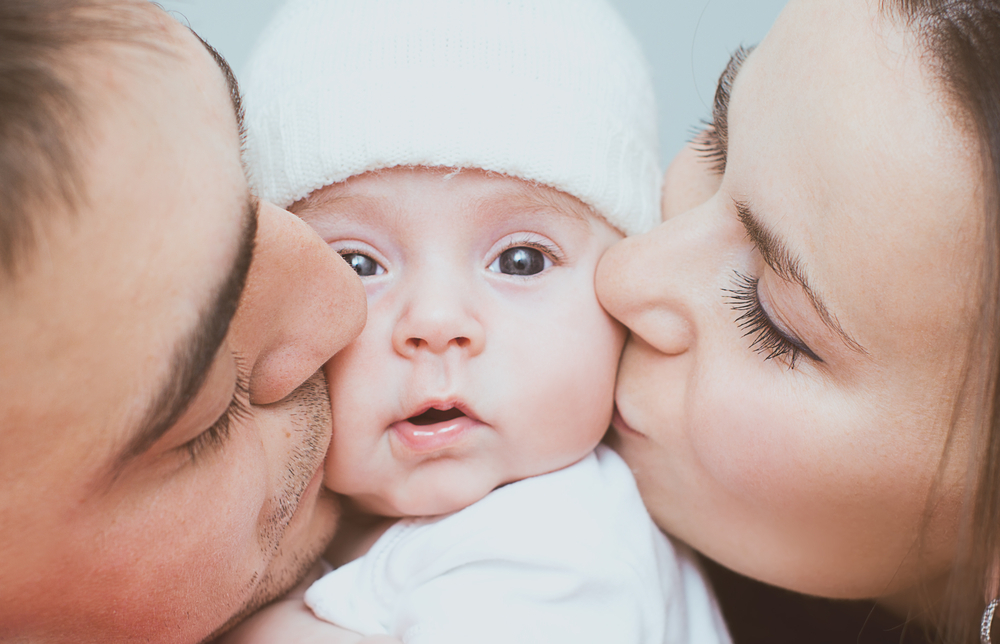Some couples find out that they are carriers of a single gene recessive disorder only after their first pregnancy. Such was the case for Emily and Adam Griffin, who then decided to pursue PGT-M (preimplantation genetic testing for monogenic/single gene disorders) for their second pregnancy. Their first child was born with an extremely rare disorder called restrictive dermopathy.
A “Pretty Normal” First Pregnancy
Emily and Adam were in their late twenties when they chose in vitro fertilization (IVF) to conceive their first child after trying for several years. Emily says that her pregnancy was “pretty normal,” though she was measuring quite large for how far along she was. Then, at 30 weeks, her water broke. After a week of stalling labor, her son was born. They knew something was wrong, but even the physicians at the hospital were stumped as to what it was. “The only way we figured out that it was restrictive dermopathy,” says Emily, “is because I was in Denver and there was a big genetics conference going on. The head of genetics came and looked at our child.”
Restrictive dermopathy is a non-survivable disorder, and Emily and Adam’s son lived only 36 hours. “After that happened, even though they were 99 percent sure it was restrictive dermopathy, my husband and I did genetic testing to confirm that, and to confirm we were carriers,” says Emily. They also tested the baby. All were a match for the same mutation.
Considering a Second Pregnancy
So how did Emily and Adam come to conceive another child? For them, this was something they wanted to pursue right away. “It had taken us so long to get pregnant the first time, I was so ready to be a mom,” says Emily. She called the fertility clinic where they had done IVF and met with them to make a game plan. “I had a million questions,” she says. “I didn’t know that our unused frozen embryos were testable, or whether we would have to do IVF a whole other time. I wondered, ‘Are we ever going to have a baby? Is it possible?'”
The good news was that her fertility center was able to thaw the embryos, biopsy them for PGT-M, and send them to a clinic that did the type of testing they needed on the sample cells. The hard part? The testing took a lot of time. The geneticists had to create a brand new probe from scratch to test for the specific genetic mutation, which created an additional four- to six-week wait, reports Emily.
To cope with the waiting, Emily said she would take the timeframe for each step — two to three weeks for their testing, four to six weeks for the probe to be created, and so on — and use the longest given time for each step to map out a total timeline in her head. It took several months in total from starting the testing process to being able to set up a transfer date with the clinic.
For many couples who pursue PGT-M, genetic material from other family members is needed by the PGT-M laboratory in order to create the test. Emily and Adam did not, but they say that whether other family members will pursue testing at some point is an “ongoing conversation.” Because the disorder is so rare, geneticists asked if Emily and Adam could possibly be related (they are not). So it is highly likely that even if other members of their family are carriers for it, their partners are likely not.
One “Bite” at a Time
Emily and Adam’s second pregnancy went very smoothly, she says, and they are now the parents to a healthy baby girl. One way Emily coped with her anxiety about the pregnancy was to keep it a secret until it was obvious. “I had to go to a specific state of mind for my own well-being, to get through it,” she says. They chose not to do prenatal testing to confirm the PGT-M results, because “I decided to put my faith in the 95% accuracy rate and go forward.”
While Emily says she felt so overwhelmed with the PGT-M process for their second pregnancy, she used coping strategies to help. Taking it one day at a time was key, she says. “One thing my husband and I said all the time to calm me down was, ‘How do you eat an elephant? One bite at a time.'” She focused on what she could control about the pregnancy — eating healthy, staying in shape, keeping her mental state positive —and let go of the things she could not control.

Lauren Arcuri is a freelance writer in northern Vermont. She writes about science, health, and medicine, including genomics, neuroscience, and rare diseases. She has written for Pacific Standard, Proto, Genome, Yoga Journal, and many other publications.
